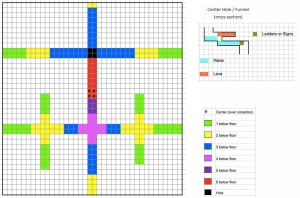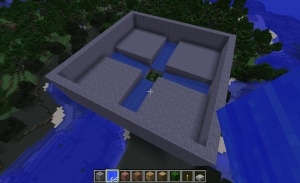The Minecraft monster spawning tower is a building that makes it easier and more convenient to obtain monster drops. It usually consists of two parts: a spacious and dark space where monsters spawn and drop to collection points, and a A monster grinder that kills them quickly and efficiently.
1. When the monster spawning tower is placed on the surface, it can provide a good monster spawning rate during the day, because it is one of the few dark environments.
2. But the spawn rate will plummet at night, because when the entire surface is dark, other places are enough to support the spawning of monsters.
3. When the monster spawning tower is built in the sky, there will be a higher monster spawning rate throughout the day, because it is the only place where monsters can be spawned.
4. However, building this kind of structure in survival mode is more difficult because when the player goes to mine, they stop working completely and the player has to stay in the sky in order to get the drops.
5. When in a super-flat world, the monster spawning tower will provide a higher monster spawning rate than other worlds, because the reduction of underground space makes monsters rarely spawn elsewhere.
6. It is difficult to build a monster spawning tower in the Nether because water will disappear and all monsters in the Nether are immune to fire, which makes quite a few monster spawning tower designs ineffective.
7. Lava may play the role of water in transportation, but it will destroy dropped items. Players can try to move monsters through the nether portal to the overworld to avoid the restrictions of hell.
Players should consider the size of the monster spawning tower. If they plan to wait for drops directly under the monster spawning tower, the radius of the monster spawning will help players easily calculate the size of the monster spawning tower:
Rounding down (square root (1024- (generating floor height - collection point floor height) ^2)) = radius of the monster spawning tower
1. The simplest and feasible design is to construct a large space with a simple shape and leave a few holes on the surface for monsters to fall.
2. Surround the edge of each hole with a sign or an open trap door to deceive the monster AI that this is solid ground.
3. The notice board requires about 0.542 wood, which is more economical than the 0.75 wood trap.
4. However, the trapdoor can be controlled by redstone, so we can remotely close the hole to shut down the monster spawning tower.
5. Cover the entire space with a roof to create the lowest light level. Roof height 3 allows the spawning of endermen, while roof height 1 will limit the monster spawning tower to spawn only spiders.
6. The monster spawning tower in the sinkhole is obviously not very efficient, because the probability of a monster falling from the hole when wandering is very small, and when the player is far away, the monster will not move and the probability of falling is zero.
7. However, the sinkhole monster spawning tower is fast and low-cost to build, and it is also effective in the lower realm.

1. An example of a 38×38 channel-type monster spawning tower.
2. To increase the probability of monsters falling into the hole, you can add a channel filled with flowing water leading to the hole in the center.
3. Place notice boards on both sides of the passage to trick monsters into falling in, and the running water will wash them to the monster grinder.
4. Such a design requires a little planning to ensure that there is no standing water that could trap monsters and thus reduce efficiency.
5. Since the system uses water to transport monsters, it will not be able to capture Endermen who will teleport away when encountering water.
6. Therefore, the roof of the tower should be covered at a height of 2 blocks above the ground to prevent the endermen from destroying the monster spawning tower.

1. There is a simple design that can be built in an 18×18 area and fill the channel with 8 water blocks so that the water stops flowing exactly at the edge of the central hole.
2. This design makes it easy to stack or place them next to each other to improve efficiency.

1. Use glass to represent the flow of water
2. If you don’t have enough space to build a large-scale design, you can try this plan.
3. This small scale 10x10 (internal area) design can easily be incorporated into a larger architectural plan.
4. The design uses four water blocks, one in each corner. The water will bypass the 3x3 platform and reach the central hole, covering the gap above the water to provide more areas for spawning monsters.